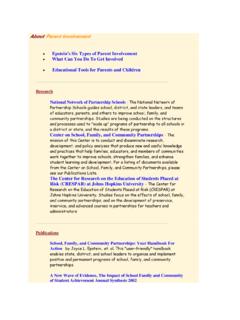Transcription of coproduction why it is important - Governance International
1 * This paper has been commissioned by LARCI to provide an overview of the personal, community and efficiency aspects of co-production in public services and adds an International perspective to the debate on co-production in the UK. In particular, the paper brings together three LARCI contributions on specific aspects of user and community involvement in public services: user involvement in public services by Catherine Needham (2009) Community involvement in public services by Simon Griffiths and Beth Foley (2009) Efficiency aspects of citizen collaborationby Elke L ffler and Peter Watt (2009) All of these papers can be found in the library section within the IDeA Community of Practice on Co-Production at Why co-production is an important topic for local government Elke L ffler, Governance International , Co-production has become an important reality in public services in the UK and internationally, as we witness greater involvement of service users and communities in the public service chain, both in extent and in intensity of engagement.
2 Indeed, as a recent report by Governance International and pollster Tns-Sofres shows, service users in five European countries are already playing a much bigger role in public services than many professionals in those countries currently realise (French Ministry of Finance, 2008). And, as Figure 1 shows, citizens in the UK scored higher than those in the Czech Republic, Denmark, France and Germany in terms of co-production in health, community safety and crime prevention. 2 Figure 1: Level of citizen co-production in Europe Level of user - involvement in Europe(environment, health, community safety)48515253560100 DenmarkFranceCzech RepublicGermanyUKThe index is a min-max (0-100) scale, with 0 representing minimum co-production (answering "never" to all the co-production questions) and 100 representing maximum (answering "often" to all the co-production questions).
3 Note: Co-production was defined in this survey as the regular participation of citizens (as individuals or in groups) in order to improve outcomes, in community safety, the local environmental and their own health or health of other people. Source: At the same time, in particular in the UK, there is now also a policy-level debate about the concept co-production among policy advisors and researchers. Most recently this debate has been given impetus by the Prime Minister s Strategy Unit (Horne and Shirley, 2009), think tanks such as the New Economics Foundation (Nef, 2008: Harris and Boyle, 2009), the Social Market Foundation (Griffiths et al, 2009), practitioner associations such as Compass (Gannon and Lawson, 2008) and the Social Care Institute for Excellence (Needham and Carr, 2009) and by academics such as Prof.
4 Tony Bovaird, Birmingham University and Marion Barnes, University of Brighton. At the European level, the issue of co-production was put firmly on the agenda of EU Ministries of Public Administration at the 4th European Quality Conference for Public Agencies in the EU in 2006 (Pollitt, Bouckaert and L ffler) and it was chosen as the core theme of the 5th European Quality Conference in 2008. Recently, the OECD has also started to focus on co-production within its agenda of promoting innovative public services. Clearly, co-production is not a new concept indeed, it is inherent in most services. It has been long understood that a key characteristic of many services is that production and consumption are inseparable.
5 Both require some contribution from the service user , as pointed out by Normann (1984) and by Zeithaml, Parasuraman and Berry (1990). 3Or as Sharp (1980: 110) puts it, co-production is the recognition that public services are the joint product of the activities of both citizens and government officials . Catherine Needham (2009) observes that the original co-production literature came from American urban scholars in the late 1970s and early 1980s, responding to fiscal cutbacks in the United States at a time of rising public expectations of services (Parks et al, 1981; Brudney, 1984). Our current renewed preoccupation with different approaches to co-production is again marked by a recession but there are also a number of other drivers as Box 1 points out.
6 Box 1: Drivers of co-production in public services Technological innovations, particularly in ICT, give citizens more control, choice and flexibility in their relations with service providers (in any sector). In the public sector, this applies quite obviously to transactional services, when citizens make use of e- government solutions. However, it also applies in social services and health, where new technologies allow patients to take responsibility for their own treatment. For example, patients with kidney problems can now run their dialysis at home so that they no longer need to go to the hospital several times a week. The latest development is health focused sensors in the home which allow remote monitoring of elderly patients for conditions including dementia so that they can stay in their own homes for longer while saving money.
7 The rapid and far-reaching value change of modern societies has had a deep impact on attitudes and behaviours of citizens (see, for example, the empirical research by Hofstede, 2001 and Inglehard, 1997). This has also led to the rise of what Griffiths et al call assertive citizens , with service users seen as less deferential and more likely to want to have a say about the services they receive (2009: 72-3). Due to demographic changes taking place in most OECD countries, there will be more citizen involvement in public services in the future. As empirical evidence for five EU countries shows, the involvement of citizens in delivering public services clearly increases with age, so that the ageing society not only means increased demand for social services but also increasing levels of co-production (French Ministry of Finance, 2008).
8 As fiscal constraints become more severe, public agencies are likely to seek to make best use of all the potential assets available to public services, including the resources which service users and communities can contribute to service outputs, quality and outcomes. While a number of co-production approaches such as e-government solutions or the replacement of paid staff by volunteers are already widely used to achieve efficiency savings, other co-production approaches such as participatory budgeting are rarely used as a strategy for getting more for less (L ffler and Watt, 2009). In particular, in the UK a greater outcome orientation of public agencies has increased awareness of public managers that outcomes are very difficult to 4achieve without some contribution from the service user (Alford, 2009: 213).
9 The key argument of co-production is that we can achieve an even higher level of outcome than by traditional service provision or self-help if we combine both the inputs of the public agency and the users and communities (L ffler and Watt, 2009). However, in many European countries there is still not a strong focus on outcomes, with the exception of health where it was always believed that health is the result of a joint effort of patients and professionals (Austrian Department of Health, 1993). In particular, ICT technology has profoundly driven and enabled new forms of collaboration between professionals and citizens. It seems very likely that it will continue to change the relationship between service professionals, service users and their communities, making citizens less dependent, while, at the same time, giving them more responsibility.
10 Although there is substantial evidence that co-production is already happening and that there is likely to be more of it in the future, there is also some research which indicates that this reality is still not well appreciated or understood by local authority professionals, managers and councillors and that, when they do become more aware of it, they sometimes resist it strongly. The first challenge for the research community, think tanks and local government umbrella organizations is to find mechanisms and a language to make professionals more aware of this concept and to help them understand why it is becoming more prevalent in practice. The second challenge is to understand better the sources of resistance to the concept.







